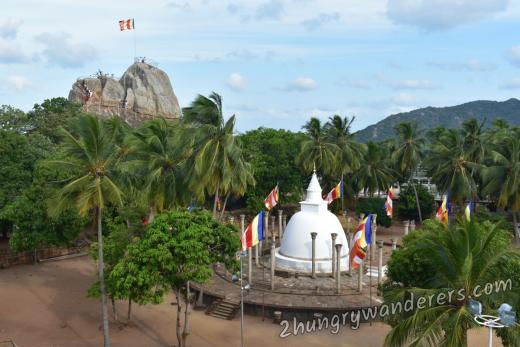
The story of Buddhism in Sri Lanka begins on the day when King Devanampiya Tissa (307-266 BC) was deer hunting and while chasing a stag he got to the top of a hill. There he met Mahinda, a Buddhist monk from India, who impressed the king so much, that the king himself, his family and court were converted to Buddhism on the spot. Mihintale means "Mahinda's plateau" and the name applies to both the hills and the small town around them, which is situated only 15 km east of Anuradhapura.
Considered the birthplace of Buddhism in the country, the area has always been deeply respected, many pagodas, other religious buildings and a monastic complex were built here. Now it is a place of both religious and historical importance, one can spend a long, full day or even better - visit on separate days to have time to explore the many ruins, ancient carvings and still functioning temples, all set amidst beautiful, lush hills.
Here we will show you the sights in the order we visited them, but the site is huge and gives plenty of options for exploring.
At the foot of the hill
Approaching the main cluster of structures to see, this is a stop that can give you a chance to relax and start with a less impressive, but still nice group of buildings.
Indikatu Seya
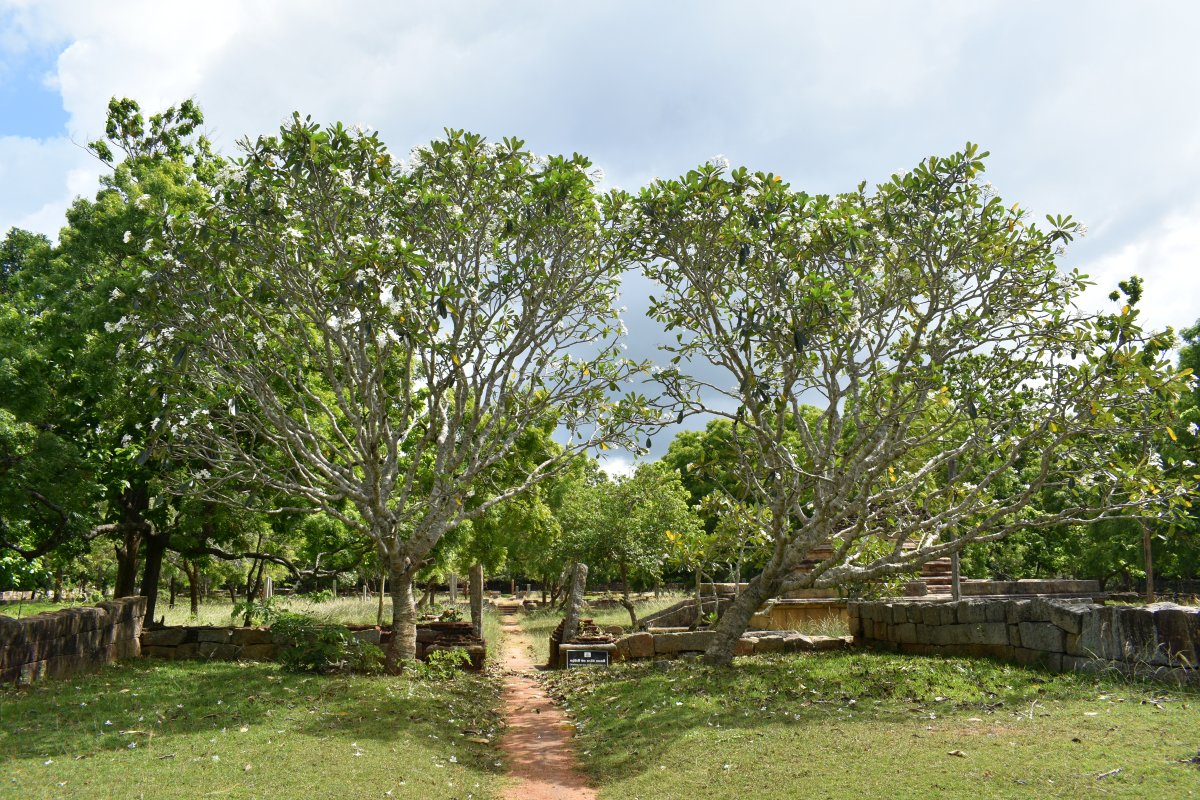
This is a whole monastic complex with several stupas, smaller buildings and a well-restored pool. It is more popular among the locals than tourists, so it is a very nice place to observe the worshipers in a less formal setting. One of the stupas is carrying the same name, which can be translated as "needle" and according to legend, the dagoba enshrines the needles used to sew monks robes.
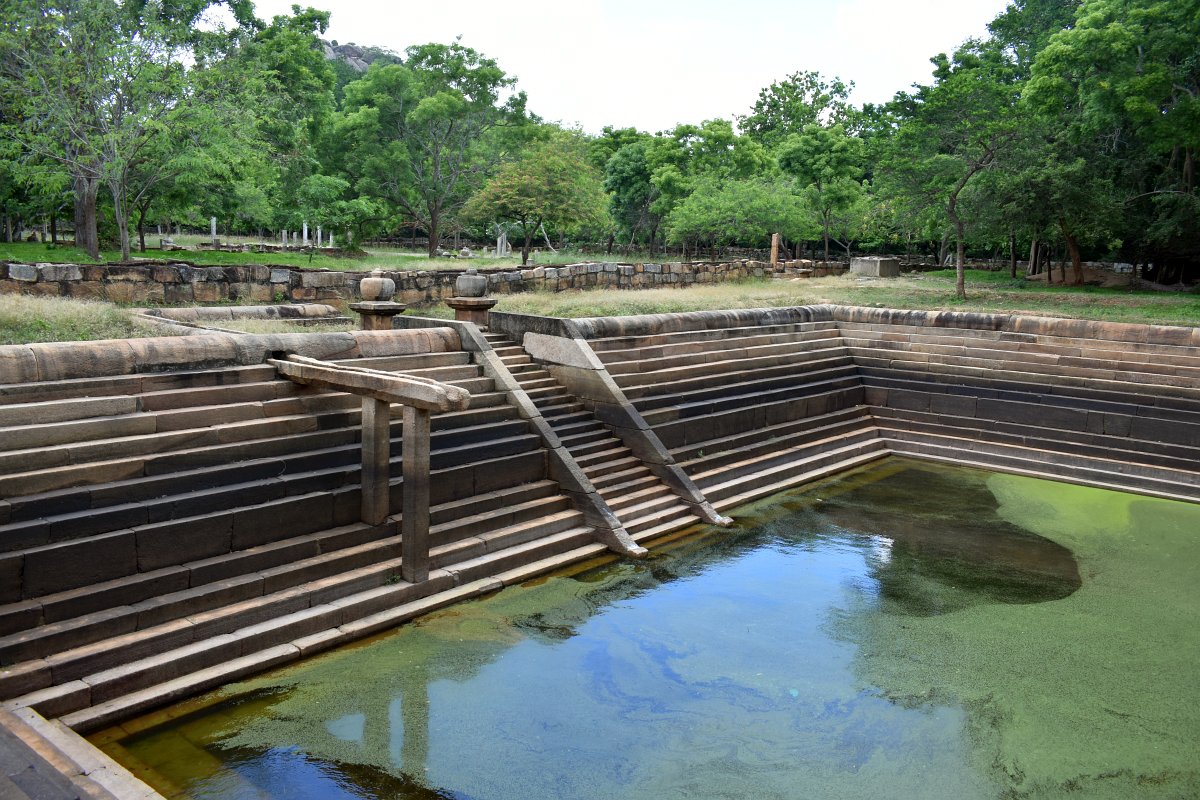
From an architectural point of view, the complex will not make you gasp in astonishment, but the notable features are the excellent water carrying systems and the five small shrines in a specific layout. Four mark the corners of a square and the fifth is in the centre, same as the 5 on a die. This pattern was popular in ancient times, but many old complexes got extended or partially damaged, destroying the original plan. Nearby, another example of this architectural layout can be found - the Mani Naga Mandira, a little down the road from the museum.
Vejja Sala - The Ancient Hospital
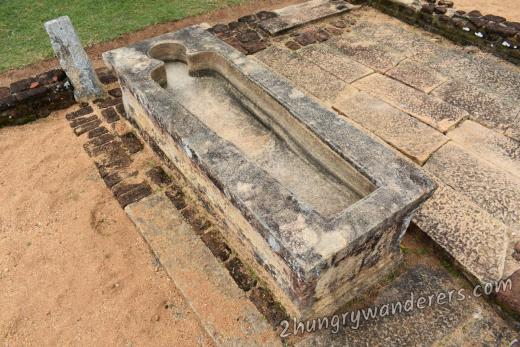
Before going up the mountain one can see the remains of a hospital, built in the 8th century which is a fine example of the well-developed health care from those times. The large size and complicated layout of the structure imply that separate departments existed, specializing in different types of illnesses. A curious object attracts the visitors' attention - a granite bath, shaped as a human body, used for soaking sick people in herb-infused oils and remedial juices. Surgical tools dated to the 12th century have also been found there. This hospital shows just one aspect of the efforts towards general well being in this prosperous area - historic documents mention specialized homes for blind and crippled people, even sick animals were taken care of by specialists.
Take the steps (or don't...)
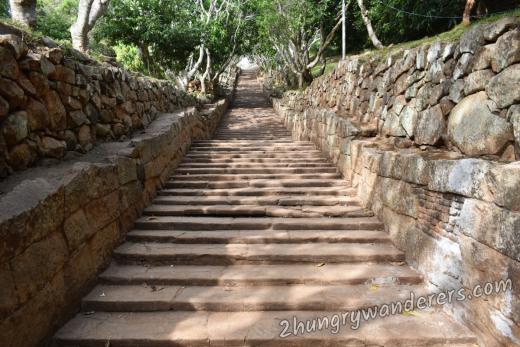
There are two options for heading up the hill, the first one is the more popular but may exhaust some of your energy too early. The huge staircase begins a bit after the museum and will get you to the first plateau. The seemingly endless steps are a must for the pilgrims but can be avoided by driving south on Kandy Rd and then east on Old Rd to the car park near the ticket counters.
That's what we did and were met by several surprised guards and staff members - we were the first tourists to visit the site in months due to the COVID-19 lockdown. Since March they hadn't seen any foreigners and in mid-June, with airports closed, they were not expecting any. After buying tickets and getting a quick overview of the path in front of us by the helpful staff, we continued to the next place of interest.
First plateau and up the hill
On your way to the top of the hill, where the most sacred buildings are located, you walk up a wide path with numerous stops and detours along.
Kantaka Chetiya

The best thing about this well preserved old stupa is its decorative elements. Partially collapsed, robbed by treasure hunters and buried for ages, now the stupa is revealed to the world. The dome has four rectangular extensions adorned with frizes and pillars that will keep you looking at them for a while. All kinds of mythical creatures, people, dwarfs, animals and flowers remain there - crafted more than 2000 years ago, some are still in excellent form.
Several drip-ledge caves can be found next to the stupa, some of them have Brahmi inscriptions indicating that the caves were used by monks as living quarters and meditation spots.
Sinha Pokuna - Lion Fountain

Amidst the ruins of some smaller buildings, the remains of what is believed to have been an open-air bath for the monks can be found. The small water tank on top of the structure was filled with water and using a spout the water was released on the side through the mouth of a life-sized, stone-carved lion. Today the lion remains as mostly a silhouette but considering some details remaining, it was probably a very intricate statue.
The frieze is better preserved and bas-reliefs depicting lions, elephants and gnomes can still be seen. Many of those elements are typical for Indian temples, reminding us of the cultural connections between the nations.
Alms hall
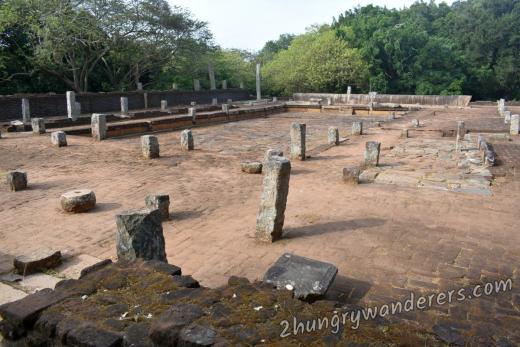
The physical remains of the monastery's dining hall are impressive - part of the area was once covered, while the main section was open air. There is a very well preserved large stone trough, also called "rice boat" - a canoe-shaped container used for storing rice that is about 10 meters long. A second, smaller trough, a "gruel boat" was used for keeping the rice porridge.
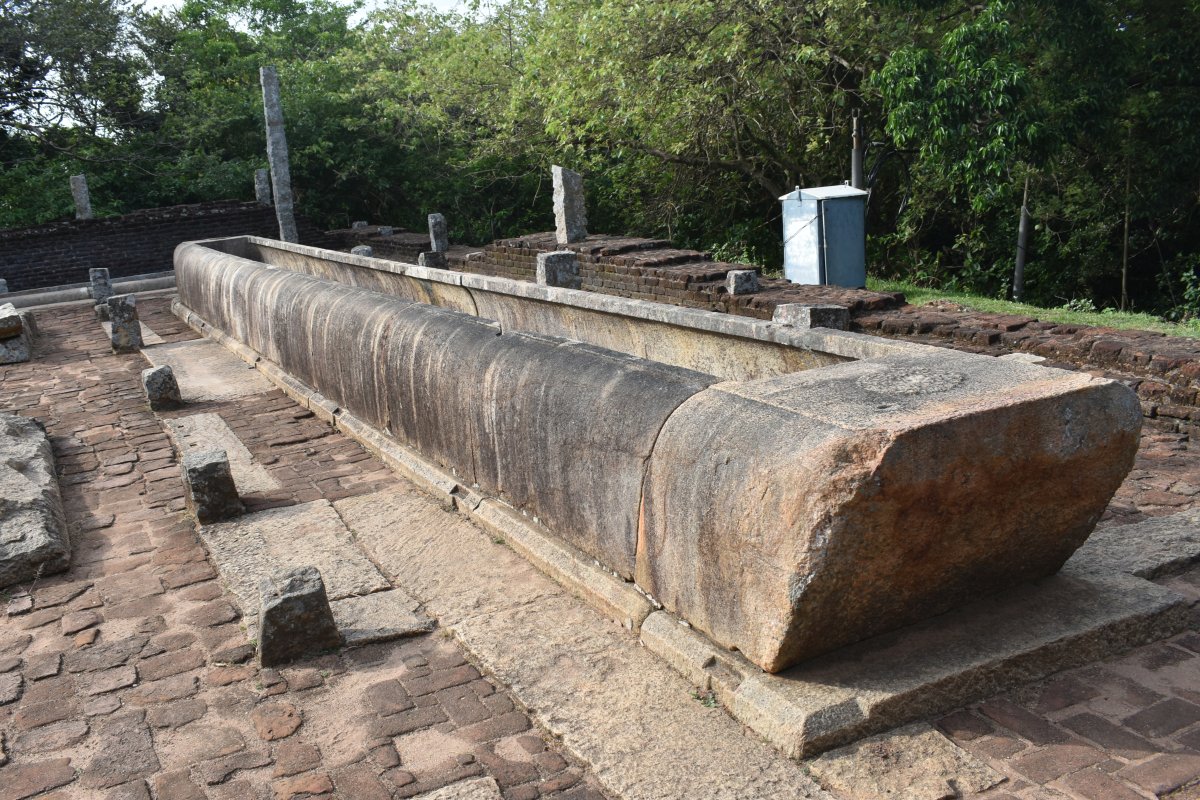
The attached kitchen had running water provided by pipes from Naga Pokuna pond uphill as well as a drainage system. To make the place even more interesting, the stone inscriptions (next point) tell us that there were 12 cooks, a warden and several people responsible just for the firewood working at the kitchen.
Slab inscriptions of Mahinda IV
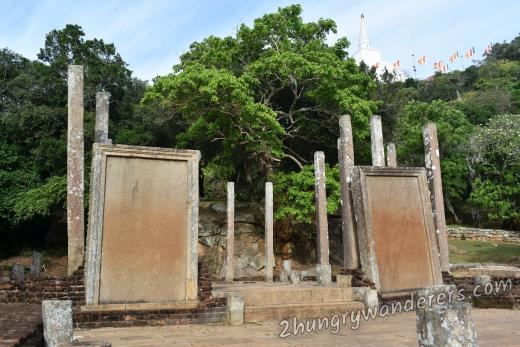
Following the path, we got to the two engraved stones that are guaranteed to capture any visitor's attention. Erected in the 10th century by King Mahinda IV (956-972), a successful ruler, they contain information highly valued by scholars today. The carved symbols give rich details about the administration of the monastery, rules and regulations for the monks, salaries for the employees and historical information regarding the buildings. Here are some of the translated writings:
The monks shall rise early morning, meditate, cleanse the teeth, and shall put on robes as described in the 'Sikha Karani'
It is believed that this is the oldest evidence of requiring businesses to keep records of their financial transactions. The detailed king's orders include specifics like keeping monthly expenditure records and preparing annual profit and loss balance sheets.
Every month accounts shall be prepared and made public.
Naga Pokuna - Snake Pond
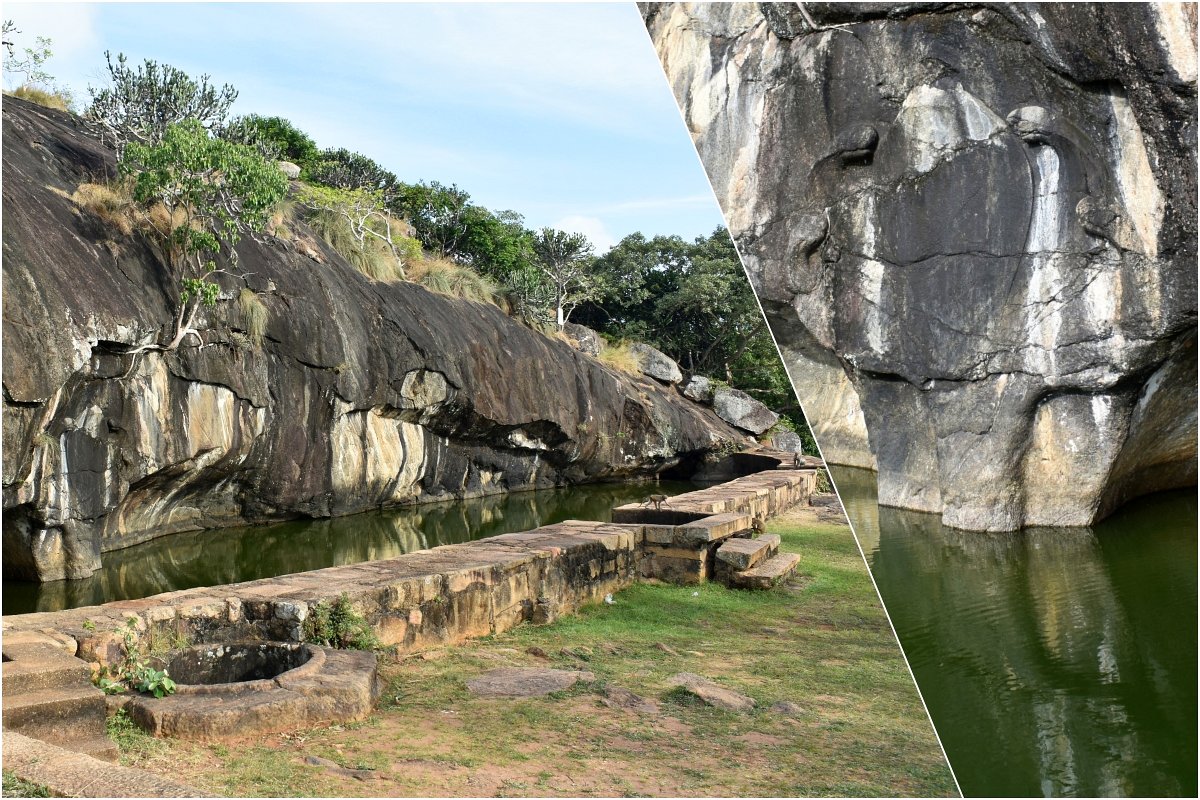
Going up the hill and following a short path to the right you will get to a small water reservoir, adorned with a single rock carving. This was once a small natural pond, which was extended as the main water source for the monastic complex. Extensive pipe system started here and provided clean water to many buildings and pools. The carving that gave the name of the pool can still be seen - a naga, mythical creature with multiple snake heads, it is said the body reaches the bottom of the pond.
Following the path from the pond, one can reach a boulder formation called "Mahinda's Cave", which is believed to have been the monk's place to meditate and sleep.
Mango-tree plateau - the hearth of Mihintale
The word "Ambasthala" can be translated as "mango-tree place" or "mango-tree plateau" which is the name of the plateau as well as the central stupa. Several stupas and other Buddhist sites with huge religious significance are located there. There are beautiful views in all directions and yes, there are mango trees as well and you can see plenty of monkeys enjoying the fruits.
Ambasthala Dagoba
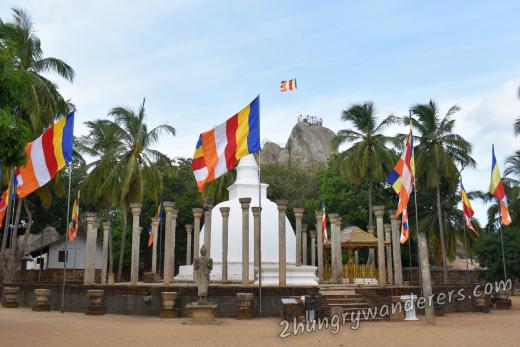
It is the holiest structure in the whole place for many reasons. First, it is believed that Buddha himself visited the spot, one of only ten on the island. Second, it is the burial place of the monk Mahinda, who brought Buddhism to Sri Lanka. Third, this is where a very important conversation happened. Mahinda wanted to test the king's wits and he did so by having a conversation with him at this spot. He actually gave the king a test, based on a what is now a high-school math topic - operations on sets. If you want to test yourself, here is the ancient text translated by Wilhelm Geiger and published in "Canadian Journal of Buddhist Studies", Number Five, 2009:
- What name does this tree bear, O king?
- This tree is called a mango tree.
- Is there yet another mango tree beside this?
- There are many mango trees.
- Are there yet other trees beside this mango and the other mangoes?
- There are many trees, sir; but those are trees that are not mango.
- And are there, beside these mangoes and those trees that are not mangoes, yet other trees?
- There is this mango tree, sir.
Impressed by the king's wisdom, the Indian monk decided he is worthy and began preaching Buddhism to him and his kingdom.
Aradhana Gala - Invitation Rock
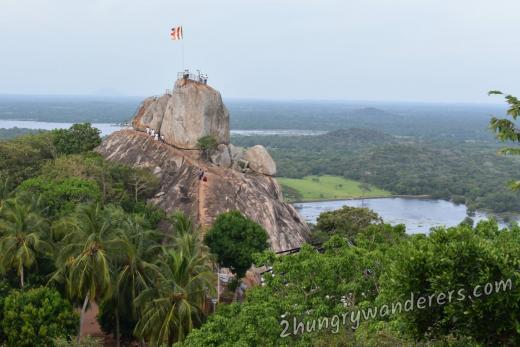
The most distinctive place is hands down the giant boulder towering over everything else for miles in every direction. According to the legend, the monk Mahinda was standing at the top of the rock when he introduced himself to the king and called him by name. King Tissa accepted the invitation for conversation and thus the name was given to the rock.
Climbing to the top is easier than expected and the views from the windswept platform are amazing. Usually, the place is crowded by worshipers, but we got a solid 10 minutes alone time there to enjoy it and take photos in every direction. In addition to the nearby hills, lakes and large patches of jungle, the high rock is the best place to observe the next three major spots nearby.
Large sitting Buddha statue
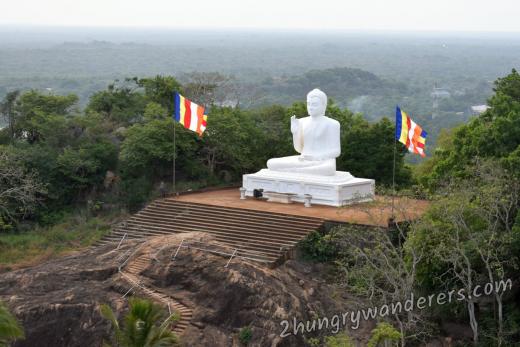
The bright white statue is a modern addition to the sacred hill.
Maha Seya (Mahaseya)
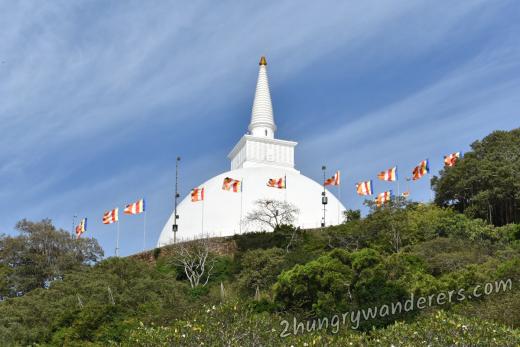
This 2000-year-old stupa was in very bad shape and had to be completely restored in the late 19th century. The white dome is larger than the original and it is said that inside the monument is stored a hair of Buddha.
Mihindu Seya
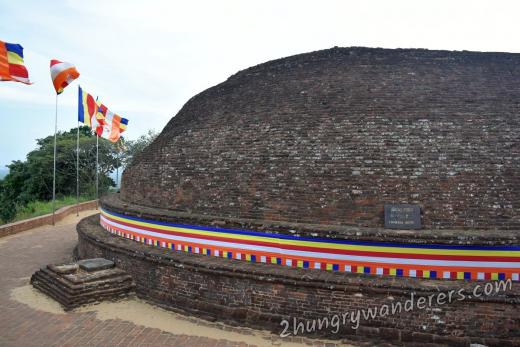
This ancient stupa remains in a state close to it's original, showing us what the dagobas looked like centuries ago. The name translates as "Mahinda's stupa" and is considered to be the burial place for the monk's ashes and some of his belongings. This theory is strongly supported by the fact that archeologists examined the relic chamber and found containers with ashes and bone fragments, as well as some beads.
Outside of the main complex
If the journey up and down the hill has left you with enough energy and time there is more to explore nearby. If you have more time in the area we recommend doing what we did - come back another day to enjoy the side attractions in Mihintale.
Kaludiya Pokuna - Dark Water Pond
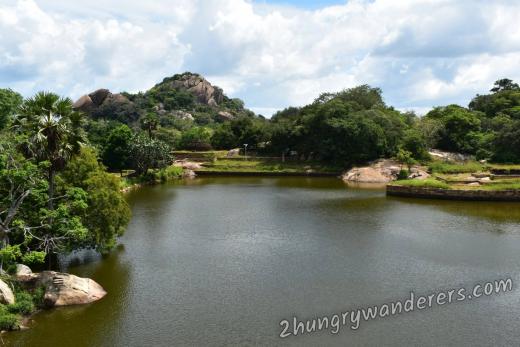
Just a kilometer from the car park near the Lion Fountain lies the largest pond in Mihintale. It is suspected that the ancient water reservoir had both decorative and practical functions, providing a beautiful setting for the monastery around it and also supplying water to a number of buildings. The former monastic complex now offers a beautiful, quiet place for a walk among some ruins.
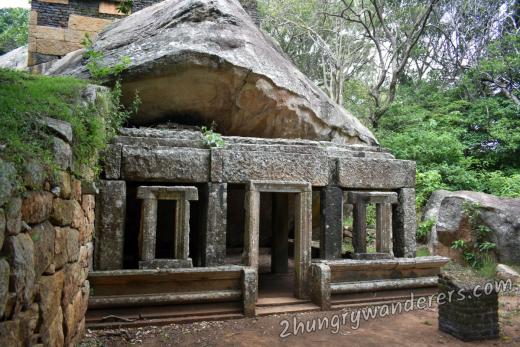
When exploring the park one can find a bathing house, cleverly built under a boulder, utilizing the space underneath it and extending it with rock walls.
Rajagiri Lena - Rajagiri Cave
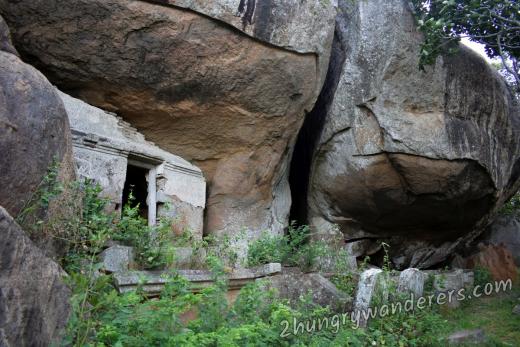
Taking a 5-minute walk from Kaludiya Pokuna's car park will take you to one of the least visited places in Mihintale. The complex of drip-ledge caves has been used by Buddhist monks for a very long time, indicated by the ancient versions of some of the discovered Brahmi inscriptions. Remains considered to be of an old image house have been discovered, as well as a developed water carrying system (canals).
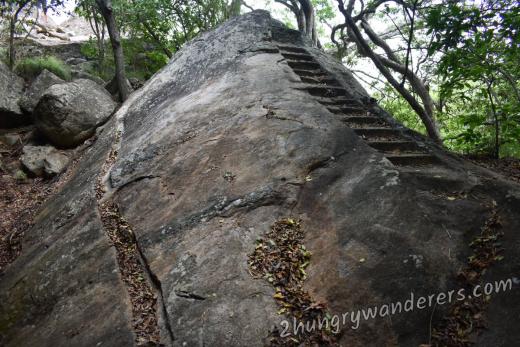
Plenty of boulders with carved steps, gutters, round and rectangular holes are scattered in the area. The purpose of most has not yet been precisely identified, but regardless they are a serious proof of the size and complexity of the cave group.
Comments